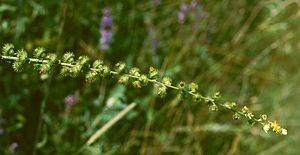Agrimonia
| Agrimony | |
|---|---|
 | |
| Genus: | Agrimonia |
| Family: | Rosaceae |
| Type: | Herbaceous perennial |
| Weediness: | Some species can be problem weeds |
| Pollination: | Insects |
Agrimony (Agrimonia) is a genus of 12–15 species of perennial plants in the family Rosaceae, native to the temperate regions of the Northern Hemisphere, with one species also in Africa.
Description
[edit | edit source]The species grow to between 0.5 and 2 m tall, with pinnate leaves, and yellow flowers borne on a single (usually unbranched) spike. The bur-like seeds are very sticky, persisting through the winter.
Growing Conditions
[edit | edit source]Species
[edit | edit source]- Agrimonia eupatoria - Common Agrimony (Europe, Asia, Africa)
- Agrimonia gryposepala - Tall Hairy Agrimony (North America)
- Agrimonia incisa - Incised Agrimony (North America)
- Agrimonia koreana - Korean Agrimony (eastern Asia)
- Agrimonia microcarpa - Smallfruit Agrimony (North America)
- Agrimonia nipponica - Japanese Agrimony (eastern Asia)
- Agrimonia parviflora - Harvestlice Agrimony (North America)
- Agrimonia pilosa - Hairy Agrimony (eastern Europe, Asia)
- Agrimonia procera - Fragrant Agrimony (Europe)
- Agrimonia pubescens - Soft Agrimony (North America)
- Agrimonia repens - Short Agrimony (southwest Asia)
- Agrimonia rostellata - Beaked Agrimony (North America)
- Agrimonia striata - Roadside Agrimony (North America)
Uses
[edit | edit source]Historically, the plants were thought to have medicinal value.
In wicca (witchcraft) it is used to help create a deep, undisturbed sleep by slipping dried leaves inside the sleeper's pillow.
Agrimonia was first described in writing by the Greeks who used it to treat conjunctivitis, other eye ailments, wounds (especially on the battle field), and liver ailments. Agrimonia is Latin, a variant of argemonia, and comes from the Greek word agermone which translates to, "speck in the eye." Eupatoria, as in agrimonia eupatoria, is derived from the name of King Mithridates IV Eupator (132 BC – 63 BC), ruler of Pontus in northern Turkey. He is well known in history for his knowledge of plant lore as well as the Mithridates Wars which he led against the Romans. Agrimonia has been used since ancient times in Egypt to treat the digestive system and in Eastern Asia it is still used to treat heavy bleeding, coughs and flu.
The Anglo Saxons knew agrimonia as "garclive", and used it for wounds, warts, snake bites and, as did the Romans, eye ailments and liver disease. English poet Michael Drayton (1563–1631) declared agrimony to be an "all heal" herb. In France and later throughout Europe it was an active ingredient in arquebusade water, which was used to treat wounds inflicted by an arquebus, a small gun operated by a matchlock mechanism dating to the 15th century.
Recent studies published by The U.S. National Institute of Health (NIH) [1] and other scientific institutions suggest that chemicals in the plant may stimulate cytokines, which are proteins that stimulate the immune system.
Maintenance
[edit | edit source]Very low maintenance, transplants easily.
Propagation
[edit | edit source]By division or seed.
Control
[edit | edit source]Control may be needed if growing where pets play, as the seeds of some species are very difficult to remove from fur and clothing.
- Mowing: Can be controlled by mowing
- Cultivation: Tilling is effective, deep roots make hand cultivation difficult.
- Pulling: Pulling is effective
- Disposal: If seeds are present, compost in hot piles only.
Harvest
[edit | edit source]Pests and Diseases
[edit | edit source]References
[edit | edit source]- Eriksson, Torsten; Malin S. Hibbs, Anne D. Yoder, Charles F. Delwiche, Michael J. Donoghue (2003). The Phylogeny of Rosoideae (Rosaceae) Based on Sequences of the Internal Transcribed Spacers (ITS) of Nuclear Ribosomal DNA and the TRNL/F Region of Chloroplast DNA. International Journal of Plant Science 164(2):197–211. 2003. (PDF version)
